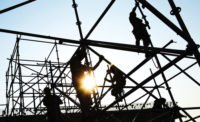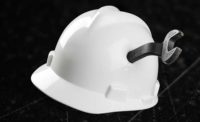Preventing Dropped objects injuries
Assess risks, train workers, mitigate hazards

Ben Franklin penned, “An ounce of prevention is worth a pound of cure.” And in cases where someone is working at a height, prevention goes well beyond personal fall protection equipment. Where fall protection equipment prevents the person from falling, a dropped object prevention plan protects people on the ground from items that can fall off of equipment or a worker.
Unconscious incompetence
While the risk of dropping an object may seem insignificant or a prevention plan superficial, consider that your conscious mind is similar to a binary computer (think “ones and zeros”); able to process only one thought at a time. When performing a given task, your brain is busy sorting information relevant to that task, say, stocking inventory 30 feet above the surface. It is not actively processing anything other than the task at hand.
If a 24-ounce pry bar perched two inches from the edge of the lift is unconsciously pushed by a worker’s foot, a major lost-time injury is likely to result as 45 foot-pounds of force (similar to the weight of a five-gallon bucket of water) bears down on an unsuspecting coworker. And if the pry bar’s sharp prongs make first contact, or it deflects after hitting the ground, the effect can be doubly devastating.
Dropped object calculator
A dropped object prevention plan helps change workers’ mindsets before they ascend to as little as five feet to change a light bulb or as high as 500 feet to align a steel beam. The plan puts equipment in place to prevent and contain an object if it is dropped. Even still, hard hats and drop zones will provide little protection if an object carries enough energy over a high enough distance. This is known as the average impact force (mgh/d), expressed in Newtons.
For those of us who don’t have a degree in engineering physics, drop calculators and charts exist on a number of safety-related websites, such as the dropped object calculator created by DROPS1 — a global network for dropped object prevention. Most dropped object calculators demonstrate the probability of injury caused by a dropped object depending on its weight and the height from which it falls.
Falling objects can be deadly
The U.S. Department of Labor’s Bureau of Labor Statistics in 2017 listed a total of 237 fatalities due to being struck by a falling object or piece of equipment. And with roughly 50,000 injuries caused by falling objects annually, these injuries account for approximately five percent of all workplace injuries.
The EHS Daily Advisor examined a segment of falling objects when it published the “Dropped Objects Prevention Survey” in May, 2019. Data from the survey reveals how EHS, safety, human resources, and business administration professionals understand the potential of dropped objects. Twenty-three percent reported a workplace injury as the direct result of a dropped object, and 19 percent reported damage to property. The survey revealed nearly three-fourths of respondents had little to no understanding of ANSI/ISEA 121-2018, and more than half said their workplace does not have a dropped object prevention plan in place.
ANSI/ISEA 121-2018, American National Standard for Dropped Object Prevention Solutions “Establish[es] minimum design, performance, testing, and labeling requirements for solutions that reduce dropped objects incidents in industrial and occupational settings,” and applies to four active-control categories: Anchor attachments, tool attachments, tool tethers, and containment.
The standard is not mandatory, but OSHA may refer to ANSI/ISEA 121-2018 if citing an employer who does not mitigate falling or dropped object hazards per its General Duty Clause.
Developing a prevention plan
To develop a dropped objects prevention plan, consider using the OSHA General Duty Clause as a foundation to a prevention plan, and ANSI 121-2018 as a basis for determining the equipment required to arrest or impede objects that can fall from a worker or piece of equipment. By first assessing all locations where work is performed at height and where objects have the potential to be dropped, you will identify potential hazards, and from there, determine what equipment is necessary to mitigate those hazards.
During your assessment, take the time necessary to talk to other coworkers and subject matter experts who work at varying heights within the facility. Their insights will also help create a prevention plan scope of work or roadmap that contains key milestones and the tasks needed to reach each milestone.
After outlining your plan and performing an initial safety assessment, begin the next milestone by implementing a primary drop system. This consists of training employees of proper tool grip as well as the proper placement of the tool when not in use, in addition to proper use of tool holsters and containment buckets as determined by the assessment.
The next step: integrating a secondary drop system as backup should the primary system fail. Secondary systems may include the following: tool arrest solutions (e.g., tool tethers, hand tool attachment straps, and transport buckets with lids). In addition to tool arrest solutions, anchorages will also need to be tested and put in place so that tethers, tools and transport containers will not fail.
Finally, determine how to measure success in a way meaningful to your goals. By including key stakeholders and employees, and incorporating closed-loop feedback throughout each phase of your dropped objects prevention plan, you will be better equipped to make necessary adjustments and improvements for ongoing success.
Source
1. https://www.dropsonline.org/resources-and-guidance/drops-calculator/e-drops-calculator/
Looking for a reprint of this article?
From high-res PDFs to custom plaques, order your copy today!







